
Western Mexico shaft tomb tradition
Encyclopedia

Jalisco
Jalisco officially Estado Libre y Soberano de Jalisco is one of the 31 states which, with the Federal District, comprise the 32 Federal Entities of Mexico. It is located in Western Mexico and divided in 125 municipalities and its capital city is Guadalajara.It is one of the more important states...
, Nayarit
Nayarit
Nayarit officially Estado Libre y Soberano de Nayarit is one of the 31 states which, with the Federal District, comprise the 32 Federal Entities of Mexico. It is divided in 20 municipalities and its capital city is Tepic.It is located in Western Mexico...
, and, to a lesser extent, Colima
Colima
Colima is one of the 31 states which, with the Federal District, make up the 32 Federal Entities of Mexico. It shares its name with its capital and main city, Colima....
to its south, roughly dating to the period between 300 BCE
Common Era
Common Era ,abbreviated as CE, is an alternative designation for the calendar era originally introduced by Dionysius Exiguus in the 6th century, traditionally identified with Anno Domini .Dates before the year 1 CE are indicated by the usage of BCE, short for Before the Common Era Common Era...
and 400 CE
Common Era
Common Era ,abbreviated as CE, is an alternative designation for the calendar era originally introduced by Dionysius Exiguus in the 6th century, traditionally identified with Anno Domini .Dates before the year 1 CE are indicated by the usage of BCE, short for Before the Common Era Common Era...
, although there is not wide agreement on this end-date. Nearly all of the artifacts associated with this shaft tomb tradition have been discovered by looters and are without provenance
Provenance
Provenance, from the French provenir, "to come from", refers to the chronology of the ownership or location of an historical object. The term was originally mostly used for works of art, but is now used in similar senses in a wide range of fields, including science and computing...
, making dating problematic. The first major undisturbed shaft tomb associated with the tradition was not discovered until 1993, at Huitzilapa, Jalisco.
Originally regarded as of Tarascan
Tarascan state
The Tarascan state was a state in pre-Columbian Mesoamerica, roughly covering the geographic area of the present-day Mexican state of Michoacán. At the time of the Spanish conquest of Mexico it was the second-largest state in Mexico. The state was founded in the early 14th century and lost its...
origin, contemporary with the Aztec
Aztec
The Aztec people were certain ethnic groups of central Mexico, particularly those groups who spoke the Nahuatl language and who dominated large parts of Mesoamerica in the 14th, 15th and 16th centuries, a period referred to as the late post-classic period in Mesoamerican chronology.Aztec is the...
s, it became apparent in the middle of the 20th century, as a result of further research, that the artifacts and tombs were instead over 1000 years older. Until recently, the looted artifacts were all that was known of the people and culture or cultures that created the shaft tombs. So little was known, in fact, that a major 1998 exhibition highlighting these artifacts was subtitled: "Art and Archaeology of the Unknown Past".
It is now thought that, although shaft tombs are widely diffused across the area, the region was not a unified cultural area
Cultural area
A cultural area or culture area is a region with one relatively homogeneous human activity or complex of activities . These areas are primarily geographical, not historical , and they are not considered equivalent to Kulturkreis .-Development:A culture area is a concept in cultural anthropology...
. Archaeologists, however, still struggle with identifying and naming the ancient western Mexico cultures of this period.
Description
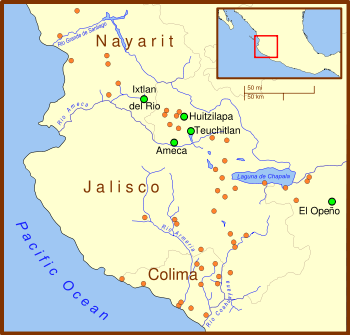
El Opeño
El Opeño is an archaeological site located in the municipality of Jacona, in the Michoacan state, México. It is home to a prehispanic site, mainly known from the ceramic material found in the funerary complexes of the site, which have been dated to the late preclassical mesoamerican period...
in Michoacán
Michoacán
Michoacán officially Estado Libre y Soberano de Michoacán de Ocampo is one of the 31 states which, with the Federal District, comprise the 32 Federal Entities of Mexico. It is divided in 113 municipalities and its capital city is Morelia...
has been dated to 1500 BCE but is linked to Central, rather than Western, Mexico. Like much else concerning the tradition, its origins are not well understood, although the valleys around Tequila, Jalisco
Tequila, Jalisco
Santiago de Tequila is a town and municipality located in the state of Jalisco about 60 km from the city of Guadalajara. Tequila is best known as being the birthplace of the drink that bears its name, “tequila,” which is made from the blue agave plant, native to this area. The heart of the...
, which include the archaeological sites of Huitzilapa and Teuchitlan, constitute its "undisputed core". The tradition lasted until at least 300 CE although there is not wide agreement on the end date.
The Western Mexico shaft tomb
Shaft tomb
A shaft tomb or shaft grave is a type of burial structure formed from a deep and narrow shaft sunk into natural rock. Burials were then placed at the bottom...
s are characterized by a vertical or nearly vertical shaft, dug 3 to 20 metres down into what is often underlying volcanic tuff
Tuff
Tuff is a type of rock consisting of consolidated volcanic ash ejected from vents during a volcanic eruption. Tuff is sometimes called tufa, particularly when used as construction material, although tufa also refers to a quite different rock. Rock that contains greater than 50% tuff is considered...
. The base of the shaft opens into one or two (occasionally more) horizontal chambers, perhaps 4 by 4 metres (varying considerably), with a low ceiling. The shaft tombs were often associated with an overlying building.
Multiple burials are found in each chamber and evidence indicates that the tombs were used for families or lineages over time. The labor involved in the creation of the shaft tombs along with the number and quality of the grave goods indicate that the tombs were used exclusively by the society's elite
Elite
Elite refers to an exceptional or privileged group that wields considerable power within its sphere of influence...
s, and demonstrate that the shaft tomb cultures were highly stratified at this early date.
Ceramic figurines and tableaus
Grave goodsGrave goods
Grave goods, in archaeology and anthropology, are the items buried along with the body.They are usually personal possessions, supplies to smooth the deceased's journey into the afterlife or offerings to the gods. Grave goods are a type of votive deposit...
within these tombs include hollow ceramic figures, obsidian
Obsidian use in Mesoamerica
Obsidian is a naturally formed volcanic glass that was an important part of the material culture of Pre-Columbian Mesoamerica. Obsidian was a highly integrated part of daily and ritual life, and its widespread and varied use may be a significant contributor to Mesoamerica's lack of metallurgy...
and shell jewelry, semi-precious stones, pottery (which often contained food), and other household implements such as spindle whorls and metate
Metate
A metate is a mortar, a ground stone tool used for processing grain and seeds. In traditional Mesoamerican culture, metates were typically used by women who would grind calcified maize and other organic materials during food preparation...
s (see this Flickr photo for a reconstruction). More unusual items include conch shell trumpets covered with stucco and other appliques. Unlike those of other Mesoamerican cultures such as the Olmec
Olmec
The Olmec were the first major Pre-Columbian civilization in Mexico. They lived in the tropical lowlands of south-central Mexico, in the modern-day states of Veracruz and Tabasco....
and the Maya
Maya civilization
The Maya is a Mesoamerican civilization, noted for the only known fully developed written language of the pre-Columbian Americas, as well as for its art, architecture, and mathematical and astronomical systems. Initially established during the Pre-Classic period The Maya is a Mesoamerican...
, shaft tomb artifacts carry little to no iconography and so are seemingly bereft of symbolic or religious meaning.
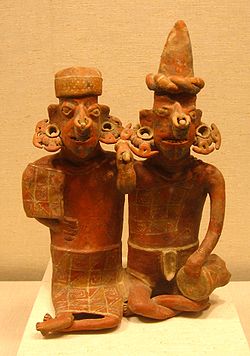
Mesoamerica
Mesoamerica is a region and culture area in the Americas, extending approximately from central Mexico to Belize, Guatemala, El Salvador, Honduras, Nicaragua, and Costa Rica, within which a number of pre-Columbian societies flourished before the Spanish colonization of the Americas in the 15th and...
. In fact, these ceramics were apparently the primary outlet for artistic expression for the shaft tomb cultures and there is little to no record of associated monumental architecture, stelae, or other public art.
Since the vast majority of these ceramics are without provenance
Provenance
Provenance, from the French provenir, "to come from", refers to the chronology of the ownership or location of an historical object. The term was originally mostly used for works of art, but is now used in similar senses in a wide range of fields, including science and computing...
, analysis has largely focused on the ceramics' styles and subjects.
Styles
The major stylistic groups include:- Ixtlan del RioIxtlán del Rio (archaeological site)Ixtlán del Rio is an archaeological site located in the Ixtlán del Rio municipality, on the south west region of the Nayarit State, Mexico. It is also known as “Los Toriles” and contains the only vestiges of the western cultures in Nayarit....
. These abstract figurines have flat, squarish bodies with highly stylized faces complete with nose rings and multiple earrings. Seated figurines have thin rope-like limbs while the standing figurines have short stocky limbs. One of the first styles to be described, noted ethnographer, and caricaturist Miguel CovarrubiasMiguel CovarrubiasJosé Miguel Covarrubias Duclaud was a Mexican painter and caricaturist, ethnologist and art historian among other interests. In 1924 at the age of 19 he moved to New York City armed with a grant from the Mexican government, tremendous talent, but very little English speaking skill. Luckily,...
stated that it "reaches the limits of absurd, brutal caricature, a peculiar aesthetic concept that relishes the creation of haunting subhuman monstrosities". Art historian George KublerGeorge KublerGeorge Alexander Kubler was an American art historian and among the foremost scholars on the art of Pre-Columbian America and Ibero-American Art....
finds that "the square bodies, grimacing mouths, and staring eyes convey a disturbing expression which is only in part resolved by the animation and plastic energy of the turgid forms".
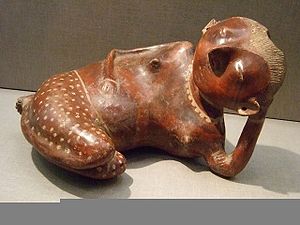
- "Chinesca" or "Chinesco" figurines were named by art dealers after their supposed Chinese-like appearance. An early type, Chinesco is identified with Nayarit and up to five major subgroups have been identified, although there is considerable overlap. Type A figurines, the so-called "classic Chinesco", are realistically rendered. One prominent curator, Michael Kan, finds that "their calm, subtle exterior suggests rather than demonstrates emotion". These Type A figures are so similar to one another that is has been suggested that they were the production of a single "school". Types B through E are more abstract, characterized by puffy, slit-like eyes blended into the face, and broad rectangular or triangular heads. These figures are often shown seated or reclining, with shortened bulbous legs quickly tapering to a point.
- The Ameca style, associated with Jalisco, is characterized by an elongated face and a high forehead which is often capped by braids or turban-like headgear. The aquiline nose is also elongated and the large eyes are wide and staring, with pronounced rims created by adding separate strips of clay ("fillets") around the eyes. The wide mouth is closed or slightly opened and the large hands have carefully delineated nails. Kubler detects both an early "sheep-faced" style that seem "eroded or melted in the continuous passages of modelling that unite rather than divide the parts of the body" and a later style which are "more animated and more incisively articulated".
.jpg)
- Colima ceramics can be identified by their smooth, round forms and their warm brown-red slipSlip (ceramics)A slip is a suspension in water of clay and/or other materials used in the production of ceramic ware. Deflocculant, such as sodium silicate, can be added to the slip to disperse the raw material particles...
. Colima is particularly known for its wide range of animal, especially dog, figurines. Human subjects within the Colima style are more "mannered and less exuberant" than other shaft tomb figurines.
Other styles include El Arenal, San Sebastián, and Zacatecas. Although there is general agreement on style names and characteristics, it is not unanimous. Moreover, these styles often overlap to one degree or another, and many figurines defy categorization.
Subject matter
Common subjects of shaft tomb tradition ceramics are:- Ceramic tableaus showing several or even several dozen people engaged in various seemingly typical activities. Concentrated in highland Nayarit and adjoining Jalisco, these tableaus present rich ethnographicEthnographyEthnography is a qualitative method aimed to learn and understand cultural phenomena which reflect the knowledge and system of meanings guiding the life of a cultural group...
insight into funeraryFuneralA funeral is a ceremony for celebrating, sanctifying, or remembering the life of a person who has died. Funerary customs comprise the complex of beliefs and practices used by a culture to remember the dead, from interment itself, to various monuments, prayers, and rituals undertaken in their honor...
practices, the Mesoamerican ballgameMesoamerican ballgameThe Mesoamerican ballgame or Tlatchtli in Náhuatl was a sport with ritual associations played since 1,000 B.C. by the pre-Columbian peoples of Ancient Mexico and Central America...
, architecture (most importantly perishable architecture), and perhaps even religious thought during the late Formative periodMesoamerican chronologyMesoamerican chronology divides the history of pre-Columbian Mesoamerica into several periods: the Paleo-Indian , the Archaic , the Preclassic , the Classic , and the Postclassic...
.
Some tableaus are almost photographic in their detail and have even been associated with architecture ruins in the field.
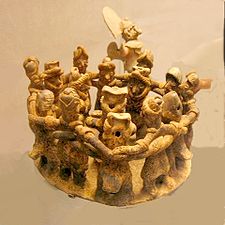
- Ceramic dogs are widely known from looted tombs in Colima. Dogs were generally believed in MesoamericaMesoamericaMesoamerica is a region and culture area in the Americas, extending approximately from central Mexico to Belize, Guatemala, El Salvador, Honduras, Nicaragua, and Costa Rica, within which a number of pre-Columbian societies flourished before the Spanish colonization of the Americas in the 15th and...
n cultures to represent soul guides of the dead and several dog ceramics wear human masks. Nonetheless, it should also be noted that dogs were often the major source of animal protein in ancient Mesoamerica.
- Ancestor (or marriage) pairs of female and male figurines are common among shaft tomb tradition grave goods. These figurines, perhaps representing ancestors, may be joined or separate and often are executed in the Ixtlán del RíoIxtlán del RíoIxtlán del Río is both a municipality and municipal seat in the Mexican state of Nayarit. In 1995 the population of the municipality was 26,137 and the total area was 581.4 km²....
style.
- Many shaft tomb figurines, spanning various Western Mexico styles and locations, wear a horn set high on the forehead. Several theories have been advanced for these horns: that they show that the figure is a shaman, that they are abstract conch shellsConchA conch is a common name which is applied to a number of different species of medium-sized to large sea snails or their shells, generally those which are large and have a high spire and a siphonal canal....
(a not uncommon shaft tomb relic) and as such, are an emblem of rulership, or are a phallic symbol. These theories are not mutually exclusive.
Uses
While these ceramics were obviously recovered as grave goodsGrave goods
Grave goods, in archaeology and anthropology, are the items buried along with the body.They are usually personal possessions, supplies to smooth the deceased's journey into the afterlife or offerings to the gods. Grave goods are a type of votive deposit...
, there is a question of whether they were specifically created for a mortuary rite, or whether they were used prior to burial, perhaps by the deceased. While some ceramics do show signs of wear, it is as yet unclear whether this was the exception or the rule.
Western Mexico cultures
Considerable effort has been made connecting the shaft tomb tradition to the Teuchitlán traditionTeuchitlan tradition
The Teuchitlan tradition was a pre-Columbian complex society that occupied areas of the modern-day Mexican states of Nayarit and Jalisco. Although evidence of Teuchitlan tradition architecture appears as early as 300 BCE, its rise is generally dated to the end of the Formative period, 200 CE. The...
, a complex society that occupies much the same geography as the shaft tomb tradition.
Unlike the typical Mesoamerican pyramids
Mesoamerican pyramids
Mesoamerican pyramids, pyramid-shaped structures, are an important part of ancient Mesoamerican architecture. These structures were usually step pyramids with temples on top – more akin to the ziggurats of Mesopotamia than to the pyramids of Ancient Egypt...
and rectangular central plazas, the Teuchitlán tradition is marked by central circular plazas and unique conical pyramids. This circular architectural style is seemingly mirrored in the many circular shaft tomb tableau scenes. Known primarily from this architecture, the Teuchitlán tradition rises at roughly the same time as the shaft tomb tradition, 300 BCE, but lasts until 900 CE, many centuries after the end of the shaft tomb tradition. The Teuchitlán tradition appears to be an outgrowth and elaboration of the shaft tomb tradition.
Mesoamerican cultures
Because western Mexico is on the very periphery of MesoamericaMesoamerica
Mesoamerica is a region and culture area in the Americas, extending approximately from central Mexico to Belize, Guatemala, El Salvador, Honduras, Nicaragua, and Costa Rica, within which a number of pre-Columbian societies flourished before the Spanish colonization of the Americas in the 15th and...
, it has long been considered outside the Mesoamerican mainstream and the cultures at this time appear to be particularly insulated from many mainstream Mesoamerican influences. For example, no Olmec
Olmec
The Olmec were the first major Pre-Columbian civilization in Mexico. They lived in the tropical lowlands of south-central Mexico, in the modern-day states of Veracruz and Tabasco....
-influenced artifacts have been recovered from shaft tombs, nor are any Mesoamerican calendars
Mesoamerican calendars
Mesoamerican calendars are the calendrical systems devised and used by the pre-Columbian cultures of Mesoamerica. In addition to the basic function of a calendar—defining and organizing periods of time in a way that allows events to be fixed, ordered and noted relative to each other and some...
or writing systems
Mesoamerican writing systems
Mesoamerica, like India, Mesopotamia, China, and Egypt, is one of the few places in the world where writing has developed independently. Mesoamerican scripts deciphered to date are logosyllabic, combining the use of logograms with a syllabary, and they are often called hieroglyphic scripts...
in evidence, although some Mesoamerican cultural markers, particularly the Mesoamerican ballgame, are present.
.jpg)
Maize
Maize known in many English-speaking countries as corn or mielie/mealie, is a grain domesticated by indigenous peoples in Mesoamerica in prehistoric times. The leafy stalk produces ears which contain seeds called kernels. Though technically a grain, maize kernels are used in cooking as a vegetable...
was supplemented with chiles, manioc and other tubers, various grains, and with animal protein from domestic dogs, turkeys, and ducks, and from hunting. They lived in thatched roof wattle-and-daub houses, grew cotton and tobacco, and conducted some long-distance trade in obsidian and other goods.
Shaft tombs themselves are not encountered elsewhere in Mesoamerica and their nearest counterparts come from northwestern South America.
South American shaft tombs
Shaft tombs also appear in northwestern South America in a somewhat later timeframe than western Mexico (e.g. 200-300 CE in northern Peru, later in other areas). To Dorothy Hosler, Professor of Archaeology and Ancient Technology at MITMassachusetts Institute of Technology
The Massachusetts Institute of Technology is a private research university located in Cambridge, Massachusetts. MIT has five schools and one college, containing a total of 32 academic departments, with a strong emphasis on scientific and technological education and research.Founded in 1861 in...
, "The physical similarities between the northern South American and West Mexican tomb types are unmistakable." while art historian George Kubler finds that the western Mexican chambers "resemble the shafted tombs of the upper Cauca river in Colombia". However, others disagree that the similarity of form demonstrates cultural linkages—Karen Olsen Bruhns states that "this sort of contact . . . seems mainly in the (muddled) eye of the synthesizer".
However, other linkages between Western Mexico and northwestern South America have been proposed, in particular the development of metallurgy. See Metallurgy in pre-Columbian Mesoamerica
Metallurgy in pre-Columbian Mesoamerica
The emergence of metallurgy in pre-Columbian Mesoamerica occurred relatively late in the region's history, with distinctive works of metal apparent in West Mexico by roughly AD 800, and perhaps as early as AD 600...
.
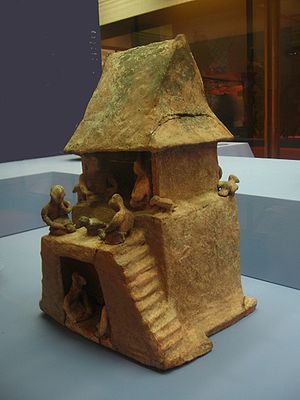
History of scholarly research
The first major work to discuss artifacts associated with the shaft tomb tradition was Carl LumholtzCarl Sofus Lumholtz
Carl Sofus Lumholtz was a Norwegian explorer and ethnographer, best known for his meticulous field research and ethnographic publications on indigenous cultures of Australia and Mesoamerican central Mexico.-Biography:...
's 1902 work, Unknown Mexico. Along with illustrations of several of the grave goods, the Norwegian explorer described a looted shaft tomb he had visited in 1896. He also visited and described the ruins of Tzintzuntzan, the seat of Tarascan empire
Tarascan state
The Tarascan state was a state in pre-Columbian Mesoamerica, roughly covering the geographic area of the present-day Mexican state of Michoacán. At the time of the Spanish conquest of Mexico it was the second-largest state in Mexico. The state was founded in the early 14th century and lost its...
some 150 miles (250 km) to the east, and was one of the first to incorrectly use the term "Tarascan" to describe the shaft tomb artifacts.
During the 1930s, artist Diego Rivera
Diego Rivera
Diego María de la Concepción Juan Nepomuceno Estanislao de la Rivera y Barrientos Acosta y Rodríguez was a prominent Mexican painter born in Guanajuato, Guanajuato, an active communist, and husband of Frida Kahlo . His large wall works in fresco helped establish the Mexican Mural Movement in...
began accumulating many Western Mexico artifacts for his private collection, a personal interest that sparked a wider public interest in West Mexican grave goods. It was in the late 1930s that one of the most prominent of Western Mexico archaeologists, Isabel Kelly, began her investigations. In the period from 1944 until 1985, Kelly would eventually publish over a dozen scholarly papers on her work in this region. In 1948, she was the first to hypothesize the existence of the "shaft tomb arc", the geographic distribution of shaft tomb sites over western Mexico (see map above).
In 1946, Salvador Toscano challenged the attribution of shaft tomb artifacts to the Tarascans, a challenge that was echoed in 1957 by Miguel Covarrubias
Miguel Covarrubias
José Miguel Covarrubias Duclaud was a Mexican painter and caricaturist, ethnologist and art historian among other interests. In 1924 at the age of 19 he moved to New York City armed with a grant from the Mexican government, tremendous talent, but very little English speaking skill. Luckily,...
who firmly declared that Tarascan culture appeared only "after the 10th century". Toscano's and Covarrubias's views were later upheld by radiocarbon dating of plundered shaft tombs' charcoal and other organic remains salvaged in the 1960s by Diego Delgado and Peter Furst. As the result of these excavations and his ethnological investigations of the modern-day indigenous Huichol and Cora people
Cora people
The Cora are an indigenous ethnic group of Western Central Mexico that live in the Sierra de Nayarit and in La Mesa de Nayar in the Mexican states of Jalisco and Nayarit. They call themselves náayarite , whence the name of the present day Mexican state of Nayarit...
s of Nayarit, Furst proposed that the artifacts were not only mere representations of ancient peoples, but also contained deeper significance. The model houses, for example, showed the living dwelling in context with the dead – a miniature cosmogram
Cosmogram
A cosmogram is a flat geometric figure depicting a cosmology. Some of them were created for meditational purpose. Mandalas are the best known cosmograms, but similar diagrams, known as schema, were also used in western Europe during the Middle Ages....
– and the horned warriors (as discussed above) were shaman battling mystical forces.
In 1974, Hasso von Winning published an exhaustive classification of Western Mexico shaft tomb artifacts (including, for example, the Chinesco A through D types mentioned above), a classification still largely in use today.
The 1993 discovery of an unlooted shaft tomb at Huitzilapa is the latest major milestone, providing "the most detailed information to date on the funerary customs" associated with shaft tomb tradition.
External links
- A Chinesco ancestor pair at the Metropolitan Museum of ArtMetropolitan Museum of ArtThe Metropolitan Museum of Art is a renowned art museum in New York City. Its permanent collection contains more than two million works, divided into nineteen curatorial departments. The main building, located on the eastern edge of Central Park along Manhattan's Museum Mile, is one of the...

